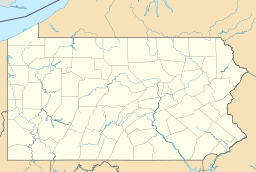Lake Choctaw facts for kids
Quick facts for kids Lake Choctaw |
|
|---|---|
| Location | Luzerne County and Schuylkill County, Pennsylvania |
| Coordinates | 40°55′46″N 76°07′49″W / 40.9294°N 76.1304°W |
| Type | manmade lake |
| Primary inflows | Sugarloaf Creek |
| Primary outflows | Sugarloaf Creek |
| Surface area | 22.1 acres (8.9 ha) |
| Shore length1 | 0.85 miles (1.37 km) |
| Surface elevation | 1,266 feet (386 m) |
| 1 Shore length is not a well-defined measure. | |
Lake Choctaw is a manmade lake and reservoir located in Luzerne County and Schuylkill County in Pennsylvania, United States. It covers an area of about 22.1 acres. The lake is fed by Sugarloaf Creek.
In the past, Lake Choctaw had poor water quality and was quite acidic. However, things changed for the better after a special treatment system was installed nearby. This system helped clean the water, making it healthy enough for fish to live in.
About Lake Choctaw
Lake Choctaw sits about 1,266 feet (386 m) above sea level. It gets its water mainly from Sugarloaf Creek. It also receives water from a place called the Oneida Number One Tunnel.
The land around Lake Choctaw has a type of rock called the Mauch Chunk Formation. The soil in the area is mostly Hazleton soil. There are some spots just south of the lake that can get flooded.
Lake Choctaw was created by a dam. This dam is known as the Lake Choctaw Dam. It was built to hold back water and form the lake.
Water Quality Story
Long ago, Lake Choctaw was very acidic, meaning its water had a low pH level. Acidic water can be harmful to many living things.
Today, the lake's water is much better! It has become alkaline, which means it has a higher pH and is less acidic. This change happened because of a special treatment system installed at the Oneida Number One Tunnel.
This system helps remove harmful substances like aluminum from the water. The lake acts like a natural filter, helping to clean the water even more.
Experts once called Lake Choctaw "once-dead" because of its poor water quality. But now, its water quality is described as "very good." It's expected to get even better in the future!
Before the treatment system was installed in 2000, the lake's pH was between 4.5 and 5.0. Just two months after the system started working, the pH jumped to between 6.5 and 7.0, which is much healthier for aquatic life.
Restoration Efforts
In the late 1900s or early 2000s, a group called the Catawissa Creek Restoration Association worked on a plan to improve the water quality of Lake Choctaw. They also helped clean up Sugarloaf Creek, Tomhicken Creek, and Catawissa Creek.
They used a special method called a passive treatment system. This system uses natural processes to clean polluted water, making it safer for the environment.
Fish and Wildlife
In the past, Lake Choctaw was not a good place for fish to live because of its poor water quality. It was considered an "infertile" lake.
However, thanks to the improved water quality, the lake is now regularly stocked with fish. The Zion Grove Trout Fishery provides these fish.
You can find different types of fish in the lake, including brook trout, brown trout, rainbow trout, and minnows. In 2007, even Freshwater jellyfish were seen in the lake! Many different aquatic insects also make their home in Lake Choctaw.



